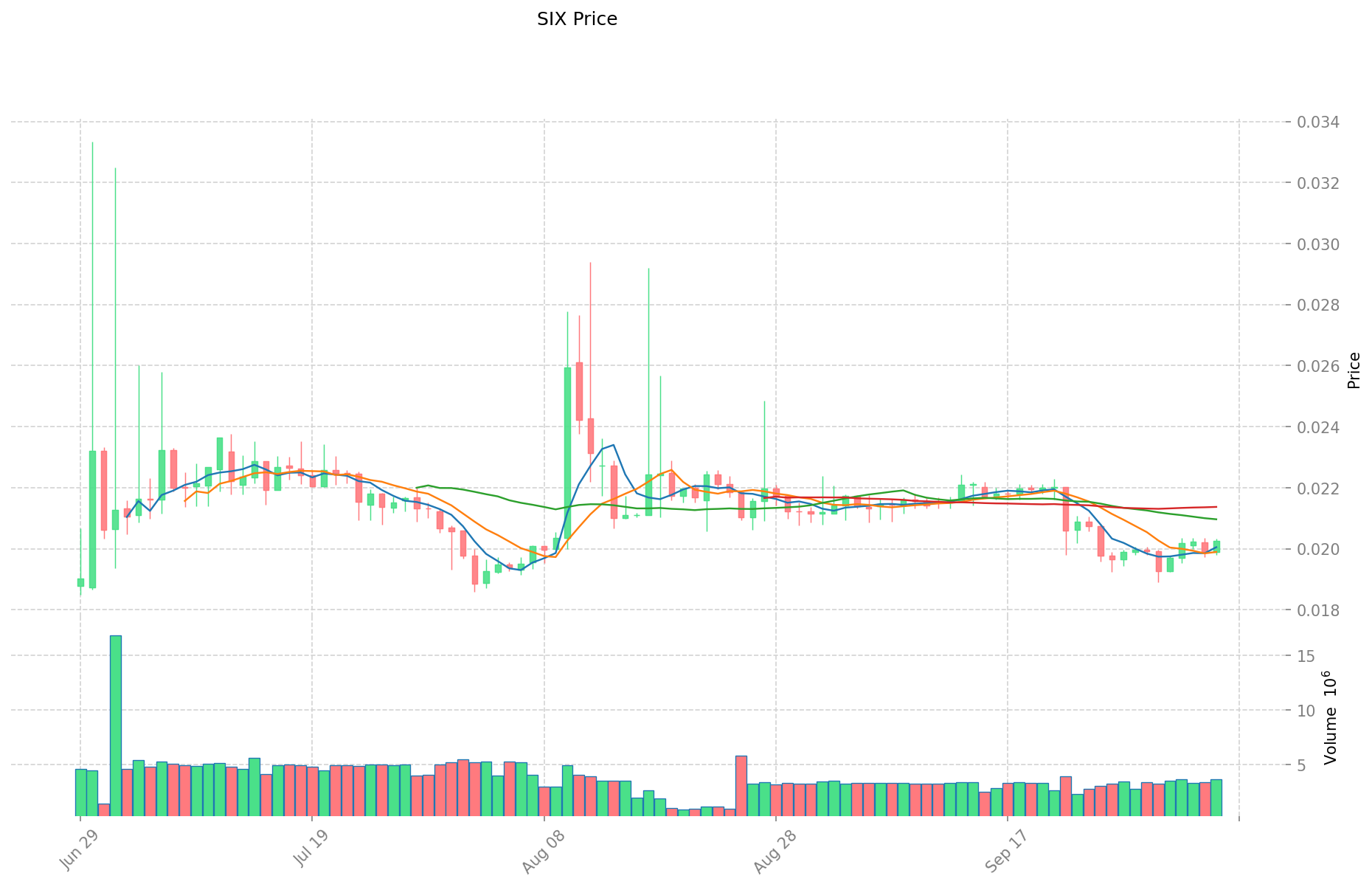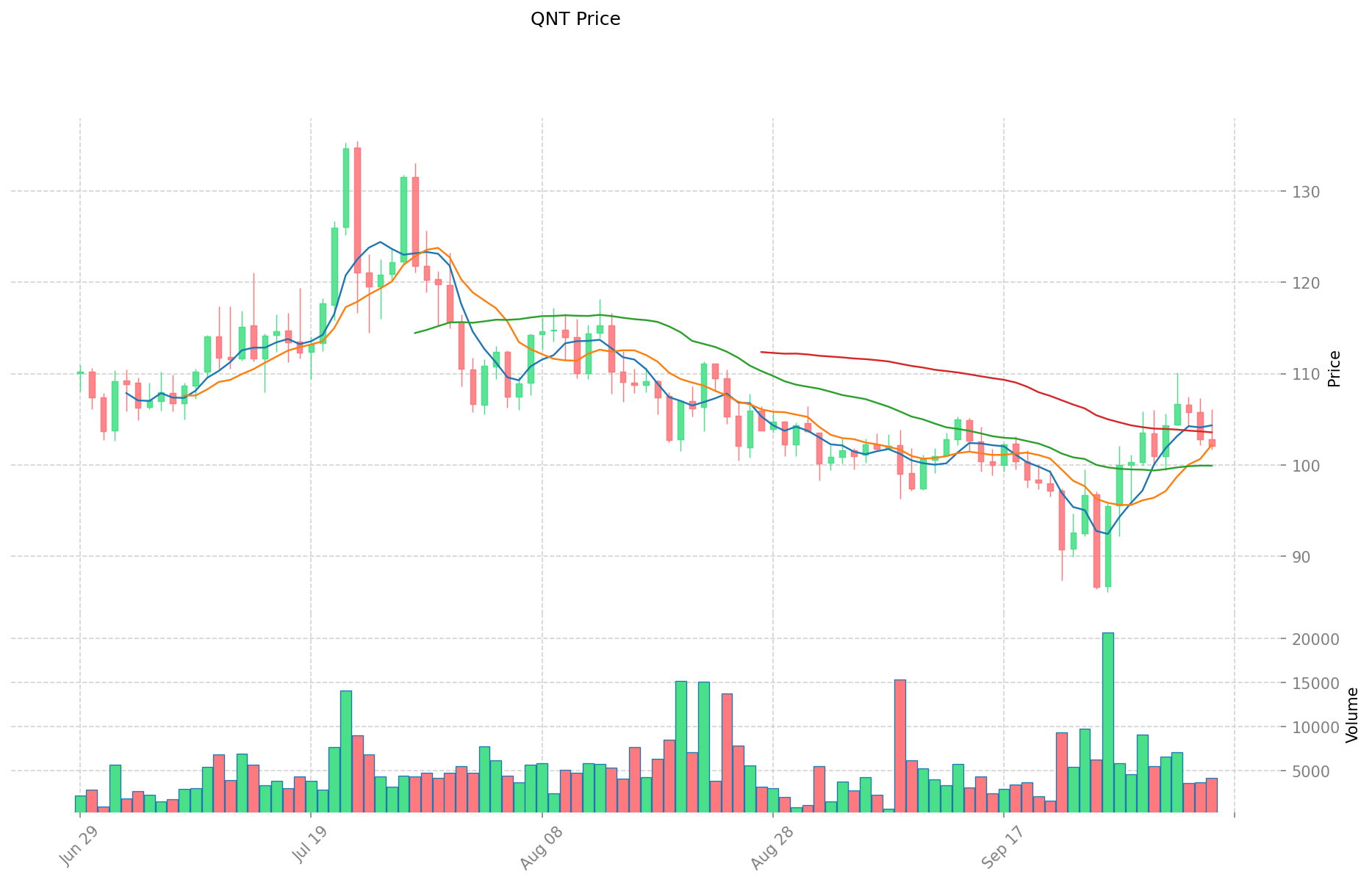SIX ve QNT: İki Lider Blockchain Teknoloji Platformunun Performans Göstergelerinin Analizi


Giriş: SIX ve QNT Yatırım Karşılaştırması
Kripto para piyasasında, SIX ve QNT karşılaştırması yatırımcılar için daima önemli bir tartışma konusu olmuştur. Bu iki varlık, piyasa değeri sıralaması, kullanım senaryoları ve fiyat performansı bakımından belirgin farklar gösterirken aynı zamanda kripto varlık ekosisteminde farklı roller üstlenir.
SIX Network (SIX): Lansmanından bu yana, şirketler için blokzincir adaptasyonunu basitleştiren ve gerçek dünya varlıklarının (RWA) tokenleştirilmesine odaklanan yaklaşımıyla piyasa tarafından kabul görmüştür.
Quant (QNT): Kuruluşundan beri, küresel blokzincir işletim sistemi inşa ederek birlikte çalışabilirlik sorununu çözmesiyle ve güvenli dijital etkileşimi mümkün kılan teknoloji sağlayıcısı rolüyle öne çıkmaktadır.
Bu makalede SIX ve QNT arasında yatırım değerine dair kapsamlı bir karşılaştırma; geçmiş fiyat trendleri, arz mekanizmaları, kurumsal benimsenme, teknoloji ekosistemi ve gelecek öngörüleri başlıklarında analiz edilecek ve yatırımcıların en çok merak ettiği şu soruya yanıt aranacaktır:
"Şu anda hangisi daha avantajlı bir alım?"
I. Fiyat Geçmişi Karşılaştırması ve Güncel Piyasa Durumu
SIX ve QNT Tarihsel Fiyat Eğilimleri
- 2021: QNT, 11 Eylül 2021 tarihinde 427,42 $ ile tüm zamanların en yüksek seviyesini gördü.
- 2024: SIX, 19 Kasım 2024 tarihinde 0,0415 $ ile en yüksek fiyatına ulaştı.
- Kıyaslama: Piyasa döngülerinde, SIX 0,0415 $’dan 0,01426 $’a inerken, QNT 427,42 $’dan 0,215773 $ ile en düşük seviyesine geriledi.
Güncel Piyasa Durumu (06 Ekim 2025)
- SIX güncel fiyatı: 0,02024 $
- QNT güncel fiyatı: 101,95 $
- 24 saatlik işlem hacmi: 74.001,93 $ (SIX) ve 426.978,88 $ (QNT)
- Piyasa Duyarlılık Endeksi (Korku & Açgözlülük Endeksi): 74 (Açgözlülük)
Anlık fiyatları inceleyin:
- SIX güncel fiyatı Piyasa Fiyatı
- QNT güncel fiyatı Piyasa Fiyatı


II. SIX ve QNT Yatırım Değerini Etkileyen Temel Unsurlar
Arz Mekanizması Karşılaştırması (Tokenomik)
- QNT: Quant Network tokeni, fiyat dinamiklerini etkileyen sabit bir arz modeline sahiptir
- 📌 Tarihsel Model: Sınırlı token arzı genellikle talep arttığında kıtlık yaratır ve bu da fiyat artışını tetikleyebilir.
Kurumsal Benimsenme ve Piyasa Kullanımları
- Kurumsal Benimsenme: QNT, faaliyete geçen Oracle blokzincir platformunun bir parçasıdır
- Birlikte Çalışabilirlik: QNT, blokzincirler arasında birlikte çalışabilirlik sunarak kullanım alanını genişletir
Teknolojik Gelişim ve Ekosistem İnşası
- QNT Teknik Gelişim: Blokzincir ağları için birlikte çalışabilirlik çözümlerine odaklanmaktadır
- Ekosistem Kıyaslaması: QNT, kurumsal blokzincir ekosisteminde birlikte çalışabilirlik protokollerine odaklanarak konumlanır
Makroekonomik ve Piyasa Döngüleri
- Piyasa Kaldıraçları: Kaldıraçlı uzun pozisyonların tasfiyesi, QNT fiyatındaki oynaklığın başlıca nedeni olarak öne çıkıyor
- Piyasa Duyarlılığı: Fiyat hareketleri, genel piyasa duyarlılığı ve işlem alışkanlıklarından güçlü biçimde etkileniyor
III. 2025-2030 Fiyat Tahminleri: SIX ve QNT
Kısa Vadeli Tahmin (2025)
- SIX: Temkinli 0,01357 $ - 0,02025 $ | İyimser 0,02025 $ - 0,02511 $
- QNT: Temkinli 81,52 $ - 101,90 $ | İyimser 101,90 $ - 149,79 $
Orta Vadeli Tahmin (2027)
- SIX, büyüme evresine geçebilir; tahmini fiyat aralığı 0,02029 $ ile 0,03186 $
- QNT, konsolidasyon döneminde olabilir; tahmini fiyat aralığı 102,69 $ ile 165,59 $
- Başlıca etkenler: Kurumsal sermaye girişi, ETF gelişmeleri, ekosistem büyümesi
Uzun Vadeli Tahmin (2030)
- SIX: Temel senaryo 0,03529 $ - 0,03976 $ | İyimser senaryo 0,03976 $ - 0,04976 $
- QNT: Temel senaryo 169,40 $ - 198,20 $ | İyimser senaryo 198,20 $ - 227,00 $
Sorumluluk Reddi: Bu analiz, geçmiş verilere ve piyasa projeksiyonlarına dayanmaktadır. Kripto para piyasası son derece oynak ve öngörülemezdir. Bu tahminler yatırım tavsiyesi değildir. Yatırım kararı almadan önce mutlaka kendi araştırmanızı yapınız.
SIX:
| Yıl | Tahmini En Yüksek Fiyat | Tahmini Ortalama Fiyat | Tahmini En Düşük Fiyat | Değişim Oranı |
|---|---|---|---|---|
| 2025 | 0.02511 | 0.02025 | 0.0135675 | 0 |
| 2026 | 0.0278964 | 0.02268 | 0.0156492 | 12 |
| 2027 | 0.031863132 | 0.0252882 | 0.020483442 | 24 |
| 2028 | 0.03800563578 | 0.028575666 | 0.01685964294 | 41 |
| 2029 | 0.0372855289968 | 0.03329065089 | 0.0306273988188 | 64 |
| 2030 | 0.049756206820194 | 0.0352880899434 | 0.022584377563776 | 74 |
QNT:
| Yıl | Tahmini En Yüksek Fiyat | Tahmini Ortalama Fiyat | Tahmini En Düşük Fiyat | Değişim Oranı |
|---|---|---|---|---|
| 2025 | 149.793 | 101.9 | 81.52 | 0 |
| 2026 | 130.88036 | 125.8465 | 65.44018 | 23 |
| 2027 | 165.5888247 | 128.36343 | 102.690744 | 25 |
| 2028 | 185.189920461 | 146.97612735 | 85.246153863 | 44 |
| 2029 | 172.72634486172 | 166.0830239055 | 127.883928407235 | 62 |
| 2030 | 227.0022770740374 | 169.40468438361 | 88.0904358794772 | 66 |
IV. Yatırım Stratejisi Karşılaştırması: SIX ve QNT
Uzun Vadeli ve Kısa Vadeli Yatırım Stratejileri
- SIX: Gerçek dünya varlık tokenizasyonu ve blokzincir adaptasyonu odaklı yatırımcılar için uygundur
- QNT: Kurumsal blokzincir çözümleri ve birlikte çalışabilirlik teknolojilerine ilgi duyan yatırımcılar için uygundur
Risk Yönetimi ve Varlık Dağılımı
- Temkinli yatırımcılar için: SIX %30, QNT %70
- Agresif yatırımcılar için: SIX %60, QNT %40
- Koruma araçları: Stabilcoin dağılımı, opsiyonlar, çapraz para portföyleri
V. Potansiyel Risk Karşılaştırması
Piyasa Riskleri
- SIX: Düşük piyasa değeri nedeniyle dalgalanma riski yüksektir
- QNT: Piyasa duyarlılığı ve kaldıraçlı işlemlerden etkilenme riski taşır
Teknik Riskler
- SIX: Ölçeklenebilirlik, ağ istikrarı
- QNT: Birlikte çalışabilirlik sorunları, potansiyel güvenlik açıkları
Düzenleyici Riskler
- Küresel regülasyon politikaları her iki token üzerinde farklı etkiler yaratabilir
VI. Sonuç: Hangisi Daha Avantajlı Alım?
📌 Yatırım Değeri Özeti:
- SIX avantajları: Gerçek dünya varlık tokenizasyonuna odaklanma, adaptasyon potansiyeli
- QNT avantajları: Kurumsal düzeyde benimsenme, birlikte çalışabilirlik çözümleri, sabit arz modeli
✅ Yatırım Tavsiyesi:
- Bireysel yatırımcılar: QNT’nin yerleşik piyasa pozisyonu nedeniyle ağırlıklı dengeli portföy önerisi
- Deneyimli yatırımcılar: Her iki varlıkta fırsat araştırılmalı, dağılım risk toleransına ve piyasa analizine göre belirlenmeli
- Kurumsal yatırımcılar: Kurumsal çözümler ve birlikte çalışabilirlik özellikleriyle QNT’yi önceliklendirmeli
⚠️ Sorumluluk Reddi: Kripto para piyasaları yüksek oynaklık barındırır. Bu makale yatırım tavsiyesi değildir. None
VII. Sıkça Sorulan Sorular
S1: SIX ve QNT arasındaki ana farklar nelerdir? C: SIX, işletmeler için blokzincir adaptasyonunu kolaylaştırma ve gerçek dünya varlıkların tokenleştirilmesine odaklanırken, QNT küresel blokzincir işletim sistemi ile birlikte çalışabilirlik sorununu çözer. QNT sabit arz modeline sahip olup, kurumsal blokzincir çözümlerinde daha köklü bir konumda yer alır.
S2: Hangi token geçmişte daha iyi fiyat performansı göstermiştir? C: QNT, Eylül 2021’de 427,42 $ ile yüksek fiyat zirvesine ulaşmıştır. SIX’in tüm zamanların en yüksek fiyatı ise Kasım 2024’te 0,0415 $’dır. Her iki token da ciddi dalgalanmalara maruz kalmıştır.
S3: SIX ve QNT’nin yatırım değerini etkileyen temel unsurlar nelerdir? C: Temel unsurlar; arz mekanizması (QNT sabit arza sahip), kurumsal benimsenme, teknik gelişim, ekosistem inşası ve makroekonomik koşullardır. QNT’nin birlikte çalışabilirlik ve kurumsal çözümlere odaklanması önemli bir ayrışma noktasıdır.
S4: 2030 için SIX ve QNT fiyat tahminleri nasıl karşılaştırılır? C: 2030’da SIX için temel senaryo 0,03529 $ - 0,03976 $, iyimser senaryo ise 0,03976 $ - 0,04976 $ arasıdır. QNT için temel senaryo 169,40 $ - 198,20 $, iyimser senaryo ise 198,20 $ - 227,00 $’dır.
S5: SIX ve QNT için hangi yatırım stratejileri önerilir? C: Temkinli yatırımcılar için portföyde %30 SIX ve %70 QNT önerilir; agresif yatırımcılar ise %60 SIX ve %40 QNT tercih edebilir. Yeni yatırımcılar, QNT’nin piyasa hakimiyeti nedeniyle dengeli ve ağırlıklı yaklaşımı seçebilir.
S6: SIX ve QNT yatırımıyla ilgili başlıca riskler nelerdir? C: Her iki token; piyasa, teknik ve regülasyon risklerine maruz kalır. SIX’in düşük piyasa değeri dalgalanmayı artırırken, QNT piyasa duyarlılığı ve kaldıraçlı işlemlerden etkilenebilir. Teknik riskler arasında SIX için ölçeklenebilirlik ve ağ istikrarı, QNT için birlikte çalışabilirlik zorlukları bulunur.
S7: Farklı yatırımcı türleri için hangi token daha avantajlı alım olarak öne çıkar? C: Yeni yatırımcılara, QNT’nin piyasa pozisyonuna hafif öncelik verilen dengeli bir yaklaşım önerilir. Tecrübeli yatırımcılar her iki varlıkta fırsatları değerlendirebilir ve dağılımı risk toleransına göre ayarlayabilir. Kurumsal yatırımcılar ise kurumsal çözümler ve birlikte çalışabilirlik nedeniyle QNT’ye ağırlık verebilir.

2025 WHITE Fiyat Tahmini: Piyasa Trendlerinin Analizi ve Gelecekteki Değer Potansiyeli

2025 PLUME Fiyat Tahmini: Gelişmekte Olan Kripto Para Birimi İçin Piyasa Trendleri ve Olası Büyüme Faktörlerinin Analizi

2025'te ONDO fiyatı ne olacak? Geçmiş eğilimler ve piyasa öngörüleri üzerinden analiz

EL vs HBAR: Farklı Kuantum Hesaplama Mimarilerinin Performansını ve Uygulamalarını Karşılaştırma

2025 BST Fiyat Tahmini: Piyasa Trendleri ve Potansiyel Büyüme Faktörlerinin Analizi

SIX Network (SIX) Yatırım İçin Uygun mu?: Dijital Ekonomi Altyapısında Büyüme Potansiyeli ve Piyasa Eğilimlerinin Değerlendirilmesi

Dropee Günlük Kombinasyonu 11 Aralık 2025

Tomarket Günlük Kombinasyonu 11 Aralık 2025

Merkeziyetsiz Finans'ta Geçici Kayıp Nedir?

Kripto Parada Çifte Harcama: Önleme Stratejileri

Kripto Ticaretinde Wyckoff Yönteminin Anlaşılması





